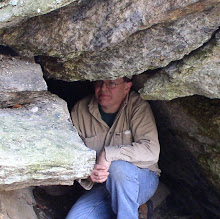Spring has come very, VERY slowly. Good days seem all too far and few between. But a roll of the dice and on up to Essex County to see how far I could go.
Day One: Working information that surfaced just after my last visit to Essex County, I trolled through the moraine containing Ship Rock in search of Kimball Rock. A few good sized boulders were encountered, although nothing nearly equaling the size of Ship Rock. At a location marked on my source map (albeit: somewhat of a small scale) the 'largest' of these boulders was found and I assume this to be Kimball Rock. Now to determine the source of its name.
Lookout Rock (mentioned as being a boulder) was given a second go now that a more definitive location was found. Several erratic extended from the crest of a hill downward. The largest, at the top, was assumed to be Lookout Rock. However, views were mostly obscured due to newer growth. A nearby outcrop along the hillside offered just a slightly better view.

Lookout RockWith a bit of time to kill, I quickly drove up the interstate into the more northerly portions of the county to try once again and identify the Ordway Boulder. A local history expert verified, on my last pass through the area, it would be in the same section of woods as the previously visited Haystack Boulder. Still no luck on this one and seeing the property is being carved up for development, I have to wonder how long future visits may be possible.
Day Two: Early morning and time to roll on to Cape Ann and Pigeon Cove. Very quickly gaining access the sea shore rocks, I began the process of identifying sites from old images. Chapin's (Great Gully) is well know, down to Singer's Rock, and on to Cathedral Rocks and the Bathing/Swimming Place. Reversing direction, I passed the Gargoyle, and looked extensively for a much sought out prize: Dick's Dream. I got up as far as the Frog (completely swamped by a ferocious surf). An abundance of marvelous dikes were to be seen along the way, but could not find what Dick might have been dreaming of.

Drawning of Dick's Dream from "Pigeon Cove and Vicinity" 1873Coming down the coast, I was pleasantly surprised to find a rock depicted on an old postcard of Pigeon Hill. In one version of this postcard, it is called Profile Rock. A somewhat marginal example of this phenomenon. But there it was, once standing proudly against the backdrop of the vista below, now surrounded by the growth of recent generations. Down below, I took in the sites available from the Granite Pier.
One longer hike out to the Devil's Den, and a short jaunt on the Old Rockport Road, finished the day.

Part of the 'Devil's Den' outcropDays Three and Four: Ah - the almighty rains rolled in over night but were light enough for me to slip out in the morning to the very rocky Poles Hill. The next morning saw very slight improvement, so I ran with it, stopping off at the Stone Chair and swinging up and around Halibut Point to Pigeon Cove once again. Despite the constant threat that rain would descend upon me, I went back out on the rocks in a slightly different area from two days previous. I came back by the Frog, spied something that looked like Dick's Dream, but gave it a thumbs down on my previous pass by two dys earlier. Not having my printouts with me, I shot a couple of photos to look over later.
Meteoric Rock was listed on the back of an old stereoview as being among these rocks. One local, theorized it to be an elevated gabbro dike which I did find. However, without the actual photo - it's hard to complete the identification. I worked back down the coast to photograph (again) Singer's Rock which had been washed out by the sunlight two days previous.

Singer's Rock: circa 1870s - above; and present day - below.
I usually like to include a Dogtown hike on each visit, but threatening weather made long treks out into the open iffy at best. Finally a decision was made to go for the Briar Swamp area and Racoon Rocks. Destination reached: the rain started slow and steady. So retreating to the car, the long journey home was made once again.





























